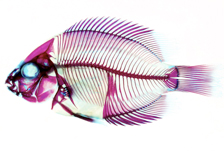- Meteorte Slices
Invigorating Vocabulary
Using classroom science magazines is an effective and stimulating way to support the Common Core’s Reading Informational Text standards. It is also a way to help you meet the key anchor standards in Reading, Writing, Speaking & Listening, and Language. And of course, your children will be learning about science and current events.
Here is a link to a story I wrote for Scholastic about the Picturing Science exhibition at the American Museum of Natural History. The Art of Science
After your students have read the story, they can investigate the activities I have developed relating to Vocabulary Acquisition and Use, one of the Anchor Standards for Reading. I have also included an Art as Science activity.

Part One:
Determine or clarify the meaning of unknown and multiple-meaning words and phrases by using context clues
Vocabulary word: DISSECT
The story explains, that instead of dissecting the fish to examine the tiny bones in their ears, Sparks uses a different technique. This technique allows him to keep all the parts that make up a fish’s ears intact. (together)
Since keeping all the parts that make up a fish’s ears intact is different from dissecting, what do you think dissecting means?
Look up the definition of dissecting. Write the meaning that best fits the word as it is used in sentence above.
Write three synonyms for dissect.

Vocabulary word: EMIT
The section on the Radiant Reef explains that fluorescent reef animals absorb blue light and emit green or red light. Another sentence says that these neon green and red creatures glow like aliens.
Since the fluorescent animals are glowing red and green, what do you think emit means?
Look up the definition of emit. Write the meaning that best fits the word as it is used in sentence above.
Write three synonyms for emit.
Part Two:
Vocabulary and Alliteration

Alliteration is the use of similar sounds at the beginning of words. For example, Cichlids are a family of fish.
To make your own phrases using alliteration, look up synonyms for the word group. Choose three synonyms and write a phrase about a group of animals for each one. Here’s an example: a bunch of bugs
You can also add an adjective: a bunch of bustling bugs
Try another one.
In the story, I described the fluorescent reef animals as a dazzling display.
Look up synonyms for the word dazzling. Choose three synonyms and write a phrase using alliteration for each one. Here’s an example: shining ship

Part Three:
Art as Science
Find something from nature that has a pattern, such as a seashell, a turtle shell, a rock, an insect wing. Using a magnifying glass or a microscope, observe the pattern up close. Now fold a piece of paper in half. On one side draw a close-up picture of the pattern. On the other side draw the whole object. (Instead of making drawings, you can also take photos.) Post your close-up picture on a bulletin board with a piece of paper below for other students to write their guesses about what they think the object is. When everyone has made their guesses, open up up the paper and re-post it so your classmates can see if they’ve guessed correctly.

